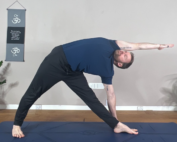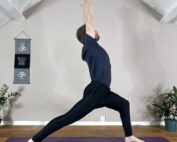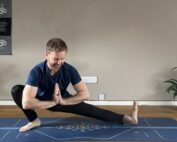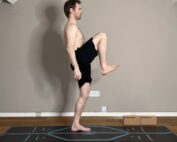
Discover the Steps and Benefits of Locust Pose (Salabhasana)
Hello! I’m Dav Jones, a yoga teacher and teacher trainer, and I’m excited to guide you through Locust Pose (Salabhasana) today. In this blog, we’ll dive deep into what the pose is, its variations, and the incredible benefits it offers. Whether you’re just starting or you’re a seasoned yoga practitioner, there’s something in here for you. Ready to strengthen, stretch, and soar with this powerful backbend? Let’s get started.
What is Locust Pose (Salabhasana)?
Locust Pose, or Salabhasana, is a gentle yet effective backbend where you lie on your belly and lift your chest, arms, and legs off the ground, hovering like a locust. This pose is all about building strength in your posterior chain (the muscles along your back), improving posture, and boosting energy. With its roots in the Sanskrit word “Salabha”, meaning locust, this pose mimics the insect’s grounded yet soaring posture, representing a balance between effort and ease.
Locust Pose (Salabhasana) Basics
- Sanskrit: Salabhasana
- Pronunciation: Sha-la-bhah-sah-nah
- Meaning: Salabha (locust) + Asana (pose/posture)
- Yoga Level: Beginner to Intermediate
- Pose Type: Backbend, strengthening
Benefits of Locust Pose (Salabhasana)
Locust Pose has many benefits for both the body and mind. Here’s a breakdown:
Physical Benefits:
- Strengthens the back: Targets muscles along your entire spine, from the hips (Glutes) lower back to the upper back, helping create muscular strength to the muscles that attach to the spine.
- Tones, glutes and hamstrings: Lifting your legs in this pose gives your glutes, hamstrings and calves a concentric (shortening) contraction.
- Opens the chest: Lifting your chest stretches and opens the front body, which helps to improve breathing efficacy in the front ribs.
- Supports digestion: The pressure on your abdomen during the lift stimulates your digestive organs, promoting better digestion.
Mental Benefits:
- Boosts energy: Backbends are energizing! This pose can help to counter feelings of fatigue.
- Increases focus: Holding this position requires concentration, helping you build mental clarity.
Step-by-Step Guide to Practicing Locust Pose

Here’s how you can practice Locust Pose step by step:
- Lie on your belly: Start by lying face down (prone) with your arms alongside your hips.
- Engage your muscles: Inhale, notice your stomach press into the mat. As you exhale, lift your chest, head, arms, and legs off the floor, engaging your back body and leg muscles.
- Focus on shortening the muscles in your back-body: Shorten the muscles in your back body including the triceps of the arms, the rhomboids between the shoulder blades, the posterior deltoids (muscles at the back of the shoulder joint), the glutes at the hips and the shortening of the calf muscles (the posterior muscles in the lower legs).
- Hold: Stay in this position for 5–10 breaths, maintaining the lift through your back muscles.
- Release slowly: On an exhale, slowly lower your body back to the floor and rest.
Tip for beginners: If lifting both legs is too challenging, start by lifting one leg at a time to build strength.
Modifications and Props
If you’re new to Locust Pose or have limited mobility, don’t worry! Here are some easy modifications:
- Use a blanket: Place a folded blanket under your hips for added comfort.
- Lift one leg at a time: For beginners, lifting one leg at a time can reduce the intensity while still building strength.
- Use a strap: For those who need more chest opening, you can hold a strap between your hands, pulling it tight as you lift your chest.
Common Mistakes to Avoid
While Locust Pose seems simple, there are some common mistakes to watch out for:
- Straining the neck: Keep your neck in a neutral position—don’t overextend it.
- Forgetting the legs: This is a full-body pose! Engage your legs and glutes to lift them off the ground.
Preparatory Poses for Locust Pose
Warming up is essential before diving into Locust Pose (Salabhasana). These preparatory poses will help activate the muscles you’ll be engaging in and increase muscle activation and joint function. By spending a few moments in these poses, you’ll set yourself up for a smoother, more effective Locust Pose practice. Here’s how:


Moving through Cat-Cow is a great way to warm up the entire spine. Starting in all- fours, alternate between arching your back (Cow) and rounding it (Cat). This dynamic movement enhances spinal mobility and stretches the back muscles. By loosening up your spine, you’ll have more flexibility and ease when transitioning into the backbend of Locust Pose. Plus, it helps lubricate the joints and prepares your body to take on more challenging poses.

This pose is perfect for engaging the spinal extensors, which are key for holding the lift in Locust Pose. Lying on your belly, place your hands beneath besides your chest. Whilst in the pose, pull forward through the chest and simultaneously press upwards with the arms. Cobra strengthens the muscles along your spine, preparing them for the full extension in Locust Pose. It also opens your chest and stretches your abdominals, making it easier to lift your chest and legs in Salabhasana.

Like the Locust Pose, the Bridge engages the posterior chain—the muscles along the back of your body, especially your glutes and hamstrings. This pose opens up your chest and shoulders, while also promoting stability and mobility in the hips. By practicing Bridge Pose, you’ll increase flexibility and strength in your lower back and legs, essential for holding a steady lift in Locust Pose. It also helps to develop body awareness of how to ground and stabilize the feet and pelvis.
Precautions and Contraindications
While Locust Pose is generally safe, here are some situations where caution is necessary:
- Pregnancy: Avoid this pose if you’re pregnant.
- Back injuries: Those with lower back issues should be cautious and may want to use props.
- Recent surgeries: If you’ve had abdominal or spinal surgery recently, it’s best to consult your doctor before practicing.
Variations of Locust Pose
There are plenty of variations you can try to suit your practice, level, or specific needs:
- Ardha Shalabhasana (Half Locust Pose):
In this variation, you lift one leg at a time while keeping the other grounded. This is a gentler version, perfect for beginners or those working on building strength. It allows you to focus on engaging your glutes independently and lower back without the intensity of lifting both legs. - Makarasana (Crocodile Pose):
This restorative version involves lying prone with your forehead resting on your hands bringing your big-toes to touch with the heels widening. Makarasana is great for winding down after a more intense practice. It helps relax the back muscles and widens the space at the sacrum.
Comparisons with Other Backbends
Curious how Locust Pose (Salabhasana) stacks up against other backbends? Here’s a quick comparison:
- Cobra Pose (Bhujangasana):

This pose focuses more on chest opening and spinal flexibility while involving. This backbend incorporates more assistance from the arms.
Bow Pose (Dhanurasana):

A more intense backbend that deeply stretches the front body, including the quads and hip flexors. It’s a full-body anterior stretch, stretching the upper and lower body including the biceps of the arms.
Final Thought
Locust Pose (Salabhasana) offers an incredible blend of physical and mental benefits. From strengthening your back, glutes, and hamstrings to creating improved posture and boosting mental focus, it’s a fantastic addition to any yoga practice. As you master the traditional pose.
To expand your practice and learn more about backbends like Locust Pose, join our mentorship program or connect with Dav Jones Yoga on Patreon for pre-recorded in-depth classes or his mentorship programs for a more 1-to-1 tailored practice approach.









